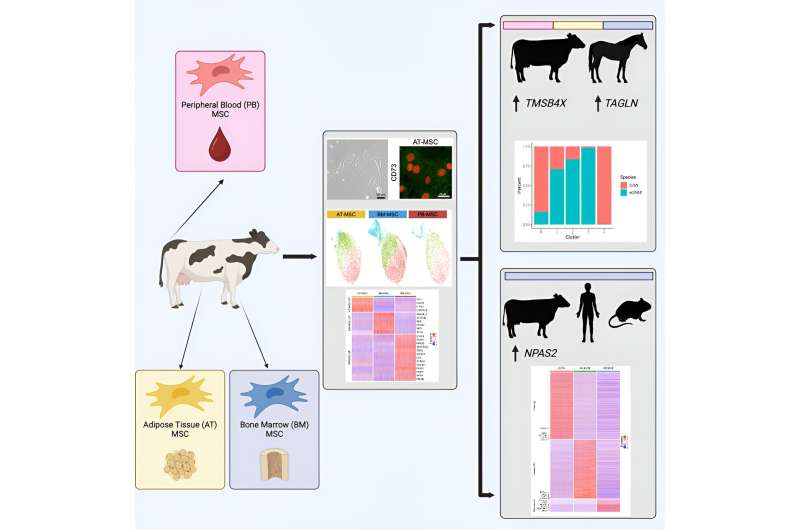This article has been reviewed according to Science X's editorial process and policies. Editors have highlighted the following attributes while ensuring the content's credibility:
fact-checked
peer-reviewed publication
trusted source
proofread
Examining the potential of the common bovine as a potential therapeutic research model

Research involving animal models—for purposes such as developing new vaccines or regenerative medicines—generally employs mice, but new Cornell research has identified another species that could be valuable to supplement this type of work.
A team led by Gerlinde Van De Walle, the Alfred H. Caspary Professor in the Department of Microbiology and Immunology in the College of Veterinary Medicine, and Jingyue (Ellie) Duan, Assistant Professor of Animal Science in the College of Agriculture and Life Sciences, found that mesenchymal stromal cells (MSCs) derived from the bone marrow of cows share more common stem cell-related gene expression profiles with human MSCs than do those from mice.
"This work is really important for actually putting the cow on the map as a valuable animal model for translational studies in regenerative medicine," said Van de Walle, a member of the Baker Institute for Animal Health.
"Every regenerative medicine therapeutic or approach that you would want to use in humans always has to be tested in an animal model first," she said. "With this work, we have shown that, at least at the transcriptomic level, the cow would also be a good model for that."
Their study, "Comparative transcriptomic analysis of bovine mesenchymal stromal cells reveals tissue-source and species-specific differences," was published in iScience. Co-first authors are Nikola Danev, a doctoral student in genetics, genomics, and development in the Van de Walle lab, and Guangsheng Li, a doctoral student in animal science in the Duan lab.
MSCs are a cell group of interest in regenerative and immunotherapeutic research. However, their use is limited due to the variation between cultures from different species and even within species among cultures taken from different tissue sources. The Food and Drug Administration has not yet granted approval for the use of MSC-based human treatments.
"If you want to use them for therapies," Van de Walle said, "it can be hit or miss based on the source they came from or the age of the donor or other factors."
The Van de Walle lab has long been studying MSCs, primarily those isolated from horses, but the group has begun to expand into other animals of agricultural importance, including the cow.
For this study, the lab isolated bovine MSCs from three sources—the peripheral blood, the bone marrow, and the adipose tissue (fat)—from the same animal and then performed transcriptomic testing to gauge the variation between the three.
Next, the transcriptomic profiles of the bovine MSCs were compared to those of MSCs from a horse, derived from the same tissue sources, and revealed several species-specific differences. Finally, the transcriptomic profile from bovine bone marrow MSCs was compared to those from mouse and human tissue, obtained from an online database of transcriptomic analyses.
"Comparative approaches are powerful tools to make inferences in biological mechanisms and the evolutionary process, but transcriptomic comparisons across species are challenging; the genomes are very divergent in sizes, gene content, and expression patterns," Duan said.
"We first analyze everything from individual species and then focused on common one-to-one orthologs (genes in different species that evolved from a common ancestral gene by speciation). This approach enables us to compare gene expression across evolutionary divergent species."
The group found that bovine bone marrow MSCs share more common functionally relevant stem cell gene expression profiles with human BM-MSCs than compared to those from mice. A caveat: This study used just one biological donor per species, so more study is needed in order to generalize the findings.
Van de Walle said cross-species comparison of MSC transcriptomic profiles is fairly rare but can generate some important data.
"Typically, everybody has their own species of interest, and they focus on that one," Van de Walle said. "But if you take the data from your species and then compare it to what is already out there, that can produce a lot of interesting extra data that you wouldn't find otherwise."
MSCs have long been thought to have strong potential in regenerative medicine, "but now more and more people are also realizing that these cells also might have antimicrobial and antiviral activities," Van de Walle said. "So the use of MSCs beyond just healing a tissue, but also as a potential alternative for antivirals or antibiotics, is being explored."
More information: Nikola Danev et al, Comparative transcriptomic analysis of bovine mesenchymal stromal cells reveals tissue-source and species-specific differences, iScience (2024). DOI: 10.1016/j.isci.2024.108886





















